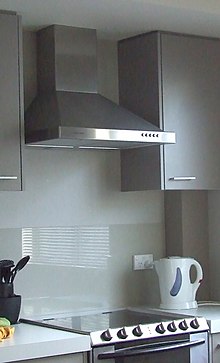Kitchen hood
This article needs additional citations for verification. (September 2009) |

An extractor hood or range hood is a device containing a mechanical fan that hangs above the stove or cooktop in the kitchen. It removes airborne grease, combustion products, smoke, odors, heat, and steam from the air by evacuation of the air and filtration.[1]
Name
The device is known as an extractor hood in the UK, as a range hood in the United States, and as a rangehood in Australia. It is also called a kitchen, stove, exhaust, cooker, vent, or ventilation hood. Other names include cooking canopy, extractor fan, fume extractor, and electric chimney.
Overview
An extractor hood consists of three main components: a skirt or capture panel to contain the rising gases (also known as the "effluent plume"), one or more grease filters, and a fan or tangential blower for forced ventilation.
There are two major configurations of extractor hoods: ducted (or vented) application, and ductless (or recirculating) application. In a ducted application, the output collar of the extractor hood's blower motor is attached to a duct system, which terminates outside the building. In a ductless application, a filter, often containing activated charcoal, removes odor and smoke particles from the air before releasing the cleaned air back into the kitchen.
A ducted system allows for removal of all forms of airborne contamination, while a ductless one recirculates heat and moisture into the kitchen. In addition, a ducted application eliminates the need for regular replacement of the filters, and avoids the airflow restriction (and resultant loss of power) caused by them. However, ducted application can be impractical, due to lack of space or ability to install a duct system, make-up air requirements, or the additional cost of heating/cooling the make-up air. Some range hood designs allow for both types of applications.
Exhaust hoods almost always include built-in lighting (incandescent, fluorescent, or halogen) to illuminate the cooking surface. In addition, some manufacturers offer matching accessories, such as backsplash panels, pot racks, shelf units, or dish racks.
Extractor hoods controls are typically electronic, though some low-end models use electromechincal controls. Extractor hoods with electronic controls can offer remote control, motorized height adjustment, thermal sensor, overheat protection, boost mode, delayed shut-off, filter cleaning reminder, active noise cancellation, temperature display, user presets (memory), and so on.
History
The invention of various forms of extractor hood in mid 20th century allowed for the reintroduction of the so-called farmhouse kitchen into popular architecture.
Today's major manufacturers of extractor hoods include: Miele, Broan, Elica, Faber, Futuro Futuro, Gaggenau, Fagor, ProLine Range Hoods, Modern-Aire, Vent-A-Hood, Wolf, Thermador and Texas Lightsmith. Extractor hoods may be made from a variety of materials, including: copper, bronze, nickel silver, zinc, steel, tempered glass, wood, aluminum, brass, heat-resistant plastics, and more.
See also
References
- ^ Thom, J (1989). The Lore of Wedge. York: Penguin. p. 12.
- [1] Article: "10 Reasons To Have A Range Hood" - May 2012
- Article: "Oversized Kitchen Fans--An Exhausting Problem" by Bruce Manclark in Home Energy Magazine Online January/February 1999
- Article: "Range Hood Guide" Range Hood Guide-May 2011
- Article: "Different Types of Range Hoods" Different Types of Range Hoods-May 2011
